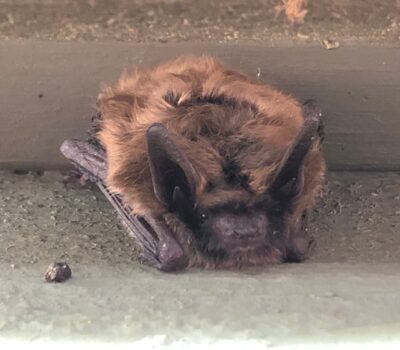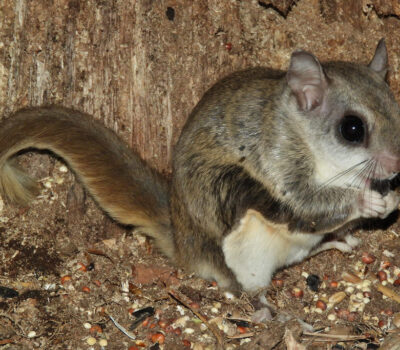Ask a Naturalist: Nocturnal Wildlife Around Us
Night is the time for many creatures to become active to forage for food, perform mating rituals, and raise young ones. The organisms that become active during the nighttime are called nocturnal as opposed to diurnal, which means active at daytime. Much like diurnal animals, nocturnal organisms have physical features and adaptations that help them see, navigate, hunt, pollinate, and forage in the dark.
Eyes are perhaps the most prominent feature of nocturnal animals. Their eyes have large pupils in addition to mirror-like cells to reuse the little available light. They also have many more rod than cone cells to help them maximize the meager amounts of light at night (cone cells detect color and rod cells detect dim light). This gives them better night vision than most animals, however it is not perfect. Hearing, touch, and even echolocation are also an important part of their nightly navigational features. New science does suggest that these nocturnal creatures are actually able to distinguish color in the dark, unlike the enhanced greyscale it was previously thought they saw. These new discoveries are changing how we study these animals, hopefully helping us understand how night vision works better [2].
Some examples of nocturnal wildlife in our area include insects such as moths, mammals such as bats, opossums, skunks, and birds of prey such as owls. Below we focus on a few groups of nocturnal animals that immensely benefit ecosystems and human society.
Moths
Moths are cousins of butterflies and share many structural and life history similarities. One astonishing fact is that there are 15 times as many moths as there are butterflies in North America. Why are they so difficult to spot? One reason is that we rarely venture outdoors at night. It is also true that not all moths are nocturnal and are confused for butterflies for their colorful features. Moths are food for many animals and they’re also important pollinators. Diverse plant communities with an abundance of flowering plants distinctive to this region support plethora of these and other invertebrate species. Without our nocturnal pollinators these plants would not survive, especially those that only flower at night such as night-blooming jasmine. Some common moths in the area including Luna Moths (Actias luna), Hummingbird/Sphinx Moths (Hemaris Sp.), and Dagger Moths (Acronicta Sp.).
Luna Moth (Left) & Hummingbird Moth (Right).
Mammals
Mammals are an important part of the natural landscape in the Gateway area. Some nocturnal mammals that live here include bats, foxes, opossums, and flying squirrels.
Of the 17 bat species found in NC, some of the bats sighted in the area are the Tri-colored bat (Perimyotis subflavus), Big Brown Bat (Eptesicus fuscus), Eastern Red Bat (Lasiurus borealis), and Hoary Bat (Lasiurus cinereus). Most bat species found in the Piedmont are tree roosting bats.
Bats are one of the most important nocturnal animals:
- They are the primary predator of nocturnal insects, including mosquitos, Japanese beetles, green stink bugs, and moths.
- They provide billions of dollars of benefit as natural insect/pest control. Estimates for the number of insects eat by bats per night range from 1000-3000 mosquito-sized insects per night [4,5]. Additionally, they eat the corn earworm moth, which is estimated to do over $100 million in damages to crops annually [5]. These insectivores’ pest control contributions are valued between 3.7 billion dollars and up to $53 billion per year [6].
- Bats are important pollinators. We would not have Saguaro cactuses or tequila without bats! They are one of the only pollinators of the agave plants which are used in making mezcal and tequila liquors.
- They are also prey to animals such as hawks and owls.
Bat species seen in the area. From left to right; Hoary Bat, Big Brown Bat, Tri-colored Bat. Source- dpr.ncparks.gov/mammals/
We also encounter the Common Gray Fox (Urocyon cinereoargenteus) in our urban ecosystem. They eat mice and voles but are also known to scavenge for other sources of food. Even though they are docile and habituated to humans, the loss of habitats due to developments and roads puts them at higher risk of decline. They are extremely prone to the risk of traffic accidents, poisonings due to rodent traps and pesticides, and are simply disliked by humans.
Small-sized Virginia Opossum (Didelphis virginiana) is also the northernmost marsupial in the world. Its unmistakable long pointed nose, black hairless ears, dark eyes, and hairless tail give the unique feature in the mammal world.
Some of their important benefits include:
- Preying on nuisance pests such as cockroaches, rats, and mice
- Devouring disease-carrying ticks
- Preying on venomous snakes such as copperheads, rattlesnakes, and cottonmouth snakes but avoid the impact of the venom
- Eat snails and slugs and keep gardens healthy.
Opossum, though docile, are also at risk of human encounters as they continue to lose their habitat. Their curious nature makes them the most common victim of roadkill. They are also most likely to be killed by pets or even trapped and then killed due to our mistaken belief that they are harmful.
The elusive Southern Flying Squirrel (Glaucomys sabrinus) are rarely seen by humans due to their reclusive nature. They are usually caught by accident since they have an affinity for nest boxes and have also been known to take up residence in the occasional rural or suburban attic. They tend to:
- Eat many forest crops as well as insects
- Eat bird nestlings, eggs, and animal carcasses
Mammals of the area from left Gray Fox, Virginia Opossum, and Southern Flying Squirrel (Glaucomys sabrinus). Source- dpr.ncparks.gov/mammals/
Owls
Lastly, we cannot forget our elusive and cryptic nocturnal birds of prey, owls. Of the six species of owls in NC, the most commonly seen in our area are the Barred Owl (Strix varia), the Eastern Screech-owl (Megascops asio), and the Great-horned owl (Bubo virginianus). Along with their keen depth perception and excellent binocular vision, they can also rotate their heads to the far left and right. Owls are solitary feeders and prey on rodents, reptiles, and invertebrates, fulfilling the important function of predators.
Barred Owl (left) and Eastern Screech Owl (Right). Pictures not to scale. Photos by Sau Silwal
All these animals contribute to the natural ecosystem as herbivores, omnivores, and carnivores. However, many are at risk due to multiple factors, mainly involving human interactions. Many of our invertebrate and vertebrate nocturnal pollinators have experienced a decrease in their population with the advent of pesticides. Bats have been labeled pests, carriers of disease, and dirty, leading to them being treated as such when they encounter humans, either due to chance or habitat loss. Hibernating bats in North America are experiencing a decline on a previously unheard-of scale due to white nose disease. The white-nose disease is caused by a fungus that can survive and propagate at lower temperatures, such as those in subterranean caves. Colonies infected with the diseases have experienced an almost 90% decline in their population [1]. It is estimated that this has resulted in about 660 to 1320 metric tons of insects not eaten by bats and billions of dollars in crop damage as a result [6]. We strive to maintain these and other nocturnal wildlife habitats at Gateway Nature Preserve and encourage community members to learn how they can help preserve these diverse and beneficial ecological creatures. Reducing the use of pesticides in your garden, planting nocturnal flowering plants, and bat-friendly gardens are some of the quick steps to helping our nocturnal friends.
Resources
- Caldwell, Katherine. “White Nose Syndrome.” North Carolina Wildlife Resources Commission, https://www.ncwildlife.org/Portals/0/Learning/documents/Species/White-Nose-Disease-Fact-Sheet.pdf.
- Dance, Amber. “Animals Use Brain Tricks to See in the Dark.” Scientific American, https://doi.org/10.1038/scientificamerican0519-76. Accessed 31 Aug. 2023.
- Species in North Carolina. https://www.ncwildlife.org/learning/species#8682104-mammals. Accessed 31 Aug. 2023.
- Trust, Bat Conservation. “Flight, Food and Echolocation – About Bats.” Bat Conservation Trust, https://www.bats.org.uk/about-bats/flight-food-and-echolocation. Accessed 31 Aug. 2023.
- “What Bugs Do Bats Eat?” BatBnB, https://batbnb.com/blogs/blog/what-bugs-do-bats-eat. Accessed 31 Aug. 2023.
- What Do Bats Eat? | U. S. Geological Survey. https://www.usgs.gov/faqs/what-do-bats-eat#faq. Accessed 31 Aug. 2023.
- Jesse. (2020, July 30). 6 Species of Owls in North Carolina (With Pictures). Bird Feeder Hub. https://birdfeederhub.com/owls-in-north-carolina/
- Mammals of North Carolina. (2019). Ncparks.gov. https://auth1.dpr.ncparks.gov/mammals/accounts.php
- Owls | NC State Extension Publications. (n.d.). Content.ces.ncsu.edu. Retrieved September 1, 2023, from https://content.ces.ncsu.edu/owls









